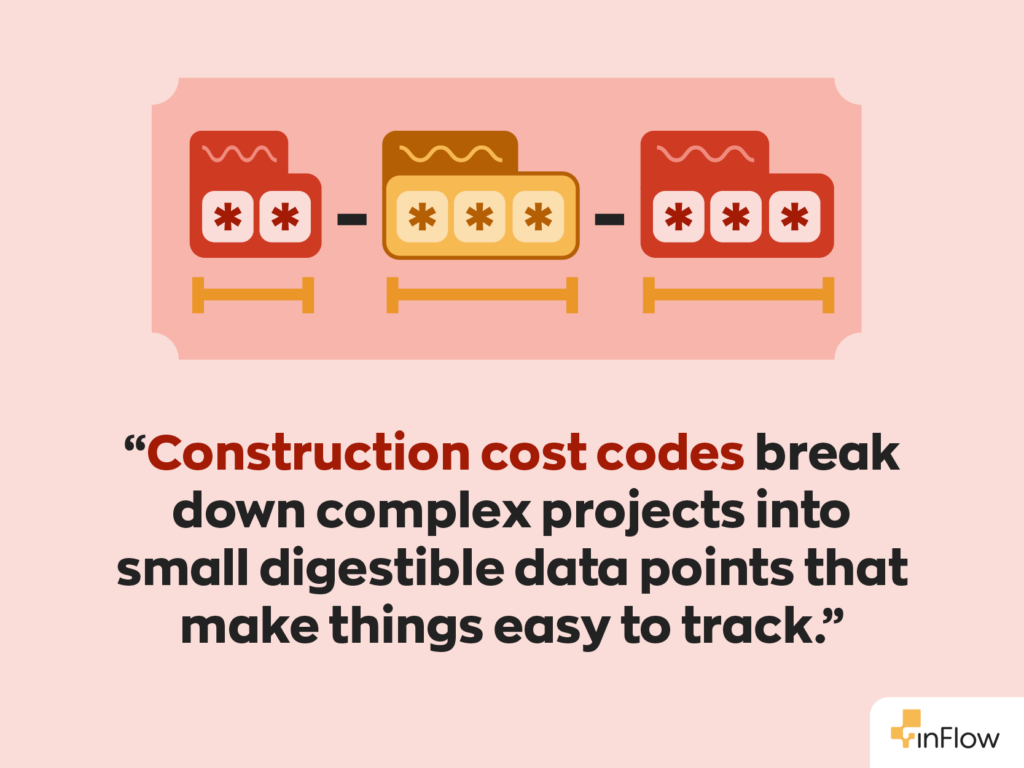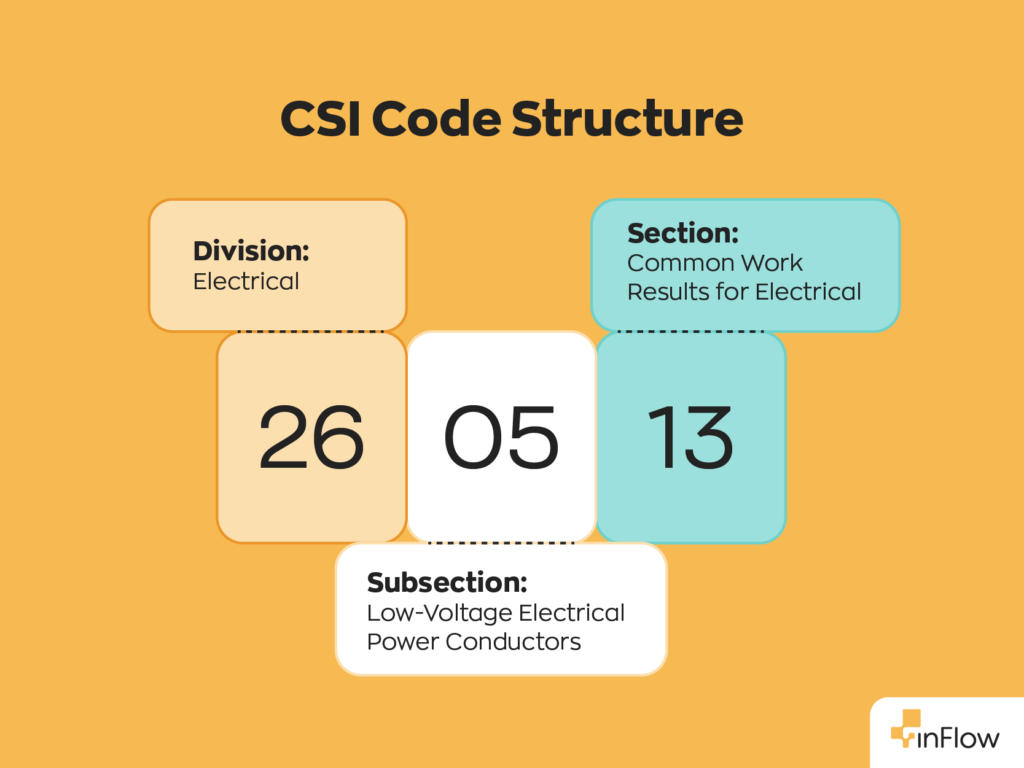Key takeaways
- Construction cost codes are an organizational method to categorize and track project expenses, providing greater financial insight.
- They are expressed in alphanumeric tags that indicate project information, such as material and labor type needed.
- These codes help businesses create accurate estimates, simplify invoicing, analyze past performance, and improve team collaboration.
- The Construction Specification Institute (CSI)’s MasterFormat is an internationally used cost code format.
- Uniformat is also used in the US and Canada, but operates in different systems than MasterFormat.
- These pre-existing cost code systems provide a consistent framework for classifying tasks and elements.
- Companies can create their own construction cost codes that are lacking from existing systems based on past projects.
Coming in on budget is one of the biggest challenges in the construction and field service industries. When you’re managing labor, equipment, subcontractors, and ever-fluctuating material costs, it’s easy for things to spiral out of control. It’s no wonder these industries are known for their brutal overhead costs- and the razor-thin margins that follow.
For this reason, construction businesses make a point of really nailing down their costs. And they use a lot of tools to do this- one of them being construction cost codes.
While you may be familiar with other common business tools like barcodes and field management software, construction cost codes are a more specialized tool, meaning they’re not as well-known.
So, what are cost codes for construction? How do they help businesses retain accounting and budgeting accuracy? There’s a lot to go over today, so let’s get right into it!
What are construction cost codes?
A construction cost code is an alphanumeric string companies use to categorize project expenses. You can think of them as labels or tags that help break down a project’s budget into manageable pieces. Each construction cost code represents a task, material, or phase of work—for example, excavation, plumbing, HVAC installation, drywall, etc.

To help illustrate, let’s make up a construction cost code of our own. We’ll use ‘3L-EL’. In this example, 3L stands for “three levels,” and EL indicates the job requires an electrician. That’s all there really is to a construction cost code. It distills information into a shorter format.
And, like we said, this is just an example to illustrate their simplicity. There are official, widely used construction codes. We’ll get to those below.
What are the benefits of cost codes for construction?
Construction cost codes enable precise tracking of project expenses and costs. They help avoid overlaps in material acquisition and layout requirements in a format that’s easy to understand. At the same time, they make it easier to estimate construction costs.
A less tangible benefit is that it makes communication much more manageable.
Construction cost codes take information and simplify it. That reduces the error rate in orders and requests. It also makes it easier to process and store. Rather than documents with long, complicated jargon, businesses can get all the information they need at a glance.
Homegrown cost codes can also ease administrative and budgeting concerns. For example, let’s say you own a construction company specializing in outdoor home add-ons—things like garages, sheds, and so on.
Between deciding on materials, ordering them, and so on, the construction information passes through quite a few layers. Requests must be made and approved, shipping organized, etc.
Additionally, construction and field service work will often require different specialized jobs, like hooking up water or electricity, and so on. Having an easy way to denote project requirements and compress information into a smaller format makes communication easier.
What are the industry standard construction cost codes?
Of course, with things like this, developing and adhering to a wide-reaching standard is often beneficial. So it’s no surprise that a couple exist here. Many contractors use these pre-established cost code systems to ensure consistency across projects.
CSI MasterFormat
The MasterFormat, developed by the Construction Specifications Institute (CSI), is an internationally recognized information standard. These CSI codes, as they’re known, are considered the gold standard for communicating and classifying construction specifications.
The CSI MasterFormat organizes work into 50 divisions (ex. Division 03: Concrete and Division 26: Electrical). Under each division, there are sections for specific tasks that add detail. An example using the codes mentioned above would be:
- 03 30 00 – Cast-in-Place Concrete
- 26 05 19 – Low-Voltage Electrical Power Conductors

The MasterFormat works exceptionally well for large-scale projects with many different teams collaborating because of the consistency in documentation, estimates, and cost tracking.
Uniformat
Another commonly used cost code for construction is Uniformat, which is mainly used in the US and Canada. However, it’s important to note that contractors use these codes in different ecosystems. They don’t compete with one another.
While MasterFormat classifies by trade and raw materials, Uniformat classifies by building systems or functional elements like substructures, shells, interiors, etc. (ex. A10: Foundations & B20: Exterior Enclosure).
Contractors use the Uniformat in the early stages of development to assist with conceptual estimates and coordinating work around building elements rather than trades.
Why are Uniformat and CSI codes so widely used?
There are a lot of vendors in the construction industry, and they all exist for a reason. They have different specialties, different certifications, and so on. They also work with one another frequently.
Imagine if all those vendors used a different categorization method for their construction cost codes. That would make communication between them nothing short of a nightmare. That’s the main reason that these widespread standards exist. They result in a communication standard that everyone understands.
However, that doesn’t mean you can’t benefit from developing your own custom construction cost codes. Every business has unique needs, and as a result, it may find it helpful to create one or two of its own.

How do construction cost codes improve budgeting?
One of the most essential things cost codes bring to the table is their ability to improve budgeting. By assigning every cost a specific code, companies can:
- Track actual costs in real-time
- Compare estimates vs actuals
- Simplify invoicing
- Generate detailed reports
When you assign each cost a code, you can hyper-focus on each expense independently. For instance, you may look at code 03-100: Plumbing Rough-In and notice that the labor exceeds the budget. Once you have this information, you can determine whether this is due to longer hours, higher rates, or scheduling delays. Without cost codes, that level of insight would be challenging and time-consuming to achieve.
How to develop your own construction cost codes
Creating your own construction cost code will ultimately depend on your needs. It’ll vary a lot from business to business, so rather than give you all the specifics, we’ll discuss the broad strokes that should largely remain the same.
Assess your needs
If you plan to create your own cost codes from scratch, chances are you have more niche things that need tracking. Otherwise, sticking with the pre-existing cost code formats would be wise. You can get a better idea of which codes you need by looking at past projects. What were some of the most common tasks, phases, trades, or materials? Did any of these things lack existing cost codes? If so, they would make suitable candidates for a new cost code.

Establish your code’s structure
You can use the CSI code format as a foundation when building out your new codes. Next, you’ll need to decide what your construction code consists of. This means how many segments it will have, what information each segment will contain, and so on. Make sure to strike the right balance. Too little information defeats the purpose, and too much information can bog down the employees who work with them.
Document your code library
Once you have your codes, it’s important to document them somewhere all employees can reference them quickly. This library should include a complete breakdown of each code to ensure there is no confusion. An example entry might be:
Code: 1300
Description: Site Grading
Includes: Equipment rental, labor, materials
Integrate cost codes into existing systems
Once you’ve set up your codes, it’s time to put them to use. Remember: construction cost codes are a tool for organizing financial operations. They should make things easier.
Using cost codes in tandem with field management software like inFlow means you’ll always know what materials you have on hand- and where to allocate them. Additionally, you can create custom fields to tag and organize items or expenses according to specific construction cost codes.
Train employees and maintain your code system
Lastly, be sure to maintain your construction cost code system. That means changing things that don’t work and revising the system as new things happen. You’ll want to conduct regular reviews to ensure efficiency, train employees accordingly, and add new technology wherever possible. It’s part of keeping up with the competition.
Final thoughts
Construction cost codes are an invaluable accounting tool that aims to give you more financial clarity. By using standardized systems like Uniformat and CSI codes and tailoring them to your specific needs, you can stay organized, maintain budgets, and make better business decisions






0 Comments